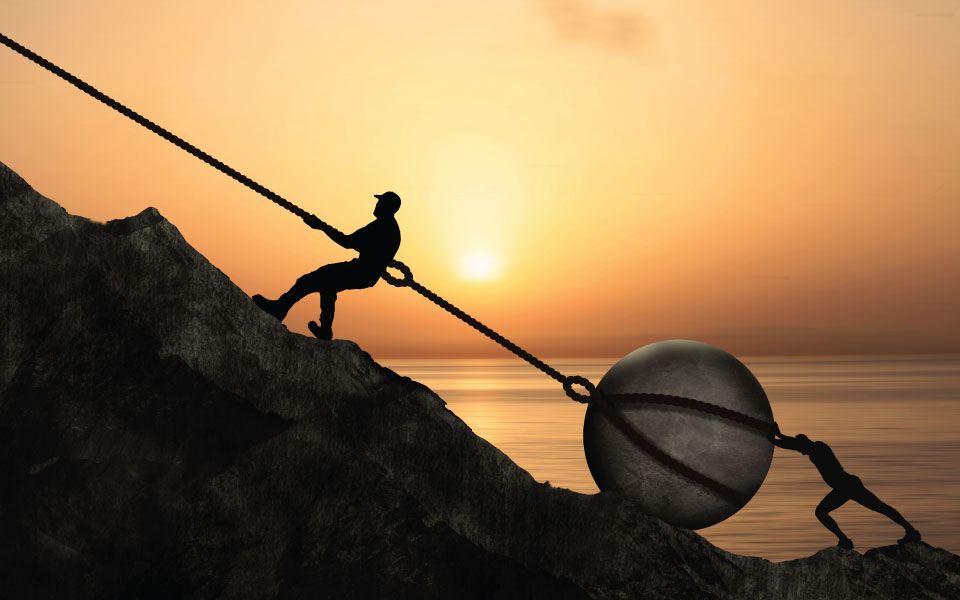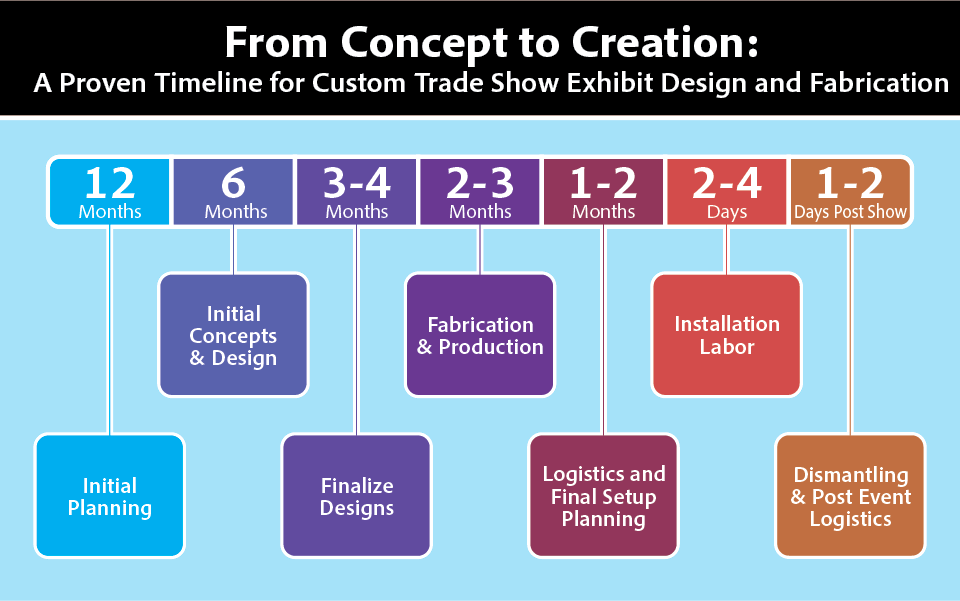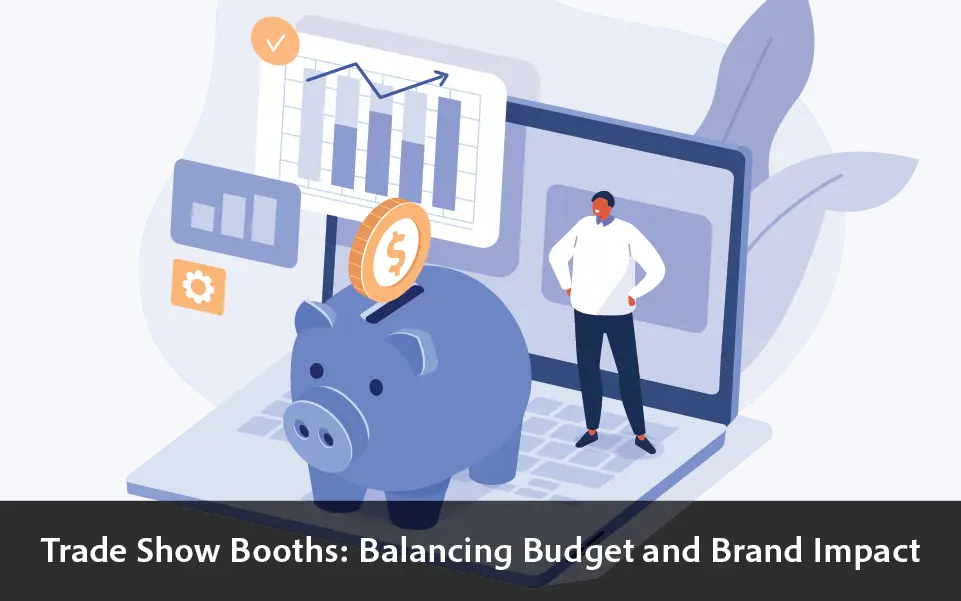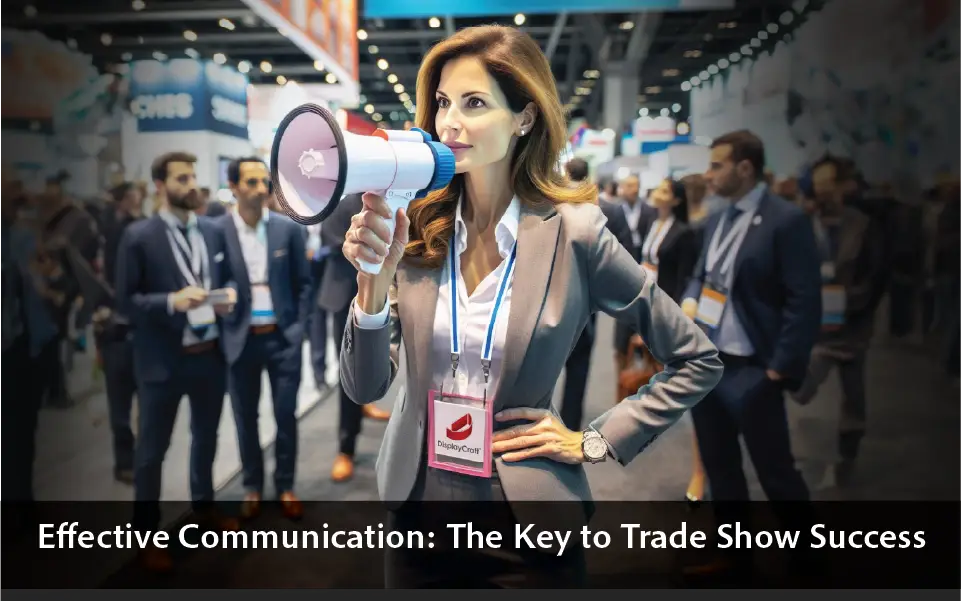What is Your Trade Show Push / Pull Marketing Strategy?
Why defining your Trade Show Push/Pull Strategy is essential to the overall success of your trade show booth design and event marketing strategy.
Richard Seigars, DisplayCraft, Inc.
As a veteran of the trade show industry, my pro-advice for ANYONE planning to exhibit, whether large or small, is to define your trade show Push/Pull Strategy. Doing so establishes the preparation required to achieve the “why” your team/company has decided to invest in/participate in any live marketing event in the first place… PLUS, it’s “what” defines the design of your tradeshow structure.
Before you design your trade show booths, make sure you have a clear Push/Pull strategy.
Push = What demonstration, presentation, messaging, visuals, announcements, questions, or information about your brand or company is essential to deliver or communicate to your target audience (attendees) Before, During, and After your event?
Pull = What critical data, commitment, participation, and action does your team/company deem essential to extract from your target audience (attendees) before, during, then after your event?
What optimal set of tools will your company deploy on the trade show floor to extract every ounce of value possible over an intense 2,3,4 days?

It Takes an Ensemble of Trade Show Marketing Strategy Efforts.
Push and pull trade show marketing elements complement one another. Every successful event strategy must employ a comprehensive mix of push-and-pull marketing efforts to maximize the opportunity, objectives, and investment.
A trade show marketing strategy is both an art and a science. There are numerous forms of push/pull trade show marketing tools: each serving its unique purposes and should be used in concert with one another rather than interchangeably.
You have to be creative to prime your audience and get your brand noticed within seconds; while being precise and intentional with your messaging headlines that spark attendee engagement and participation with your brand and team.
By defining your audience-product/service fit, you can develop the right strategies and tools for reaching their undivided attention, resonating with them, and, most of all, sparking engagement on the show floor, leading to fruition. That’s where your booth mojo kicks in to push your critical strategy while pulling your target necessary data.
I know what you’re wondering. So now that I know this, now what?
Let’s first learn a bit more about push and pull.
The Push: Examples of PUSH marketing.
Push marketing comes in various forms and is far more intrusive than pull marketing.
Members of your target audience are either actively or not seeking your messaging, but still, you are pushing content about your product or services directly to them. Delivery of push marketing strategies is available in various forms, such as logos, signage, graphics, digital displays, cold emailing or phone calls, SMS messaging, newsletters, sponsorships, invitations, promotions, social media marketing, publication advertising, direct mail, etc.
The rule-of-thumb that states that “5-7 impressions are critical to spark engagement or a memory of a brand or promotion” still holds strong. It would be best to communicate to your company’s stakeholders that investment is necessary before, during, and after your trade show to deliver enough resonating content to reach a “5-7” goal. Remember, the trade show itself is only a single FANTASTIC component of the whole and will account for perhaps one or two of the five or seven necessary impressions required for success.
Some additional “push” examples include:
- Podcast sponsorships
- Webinars
- Geo-fencing
- Radio/TV commercials
Pre-show promotion – There are numerous pre-show push marketing strategies, also known as outbound marketing, from super-affordable and straightforward to complex, multifaceted expensive-upfront-to-deploy processes. It’s your budget, not ours, so what your company can afford to invest upfront to obtain a greater return later is not my call. However, I highly recommend investing as much effort and capital in your pre-show priming and post-show follow-through or follow-up as you did in the trade show. Consider each effort one-third of the whole. Define your audience, goals, and the best delivery options for your team to reach your goals.
Pre-show push marketing is a type of marketing that kicks off your trade show marketing strategy by delivering your event participation announcement and invitation process. This is the spark or beginning of the conversation with your target audience. For your messaging to capture your audience’s attention, we recommend that your approach be strategized and cleverly crafted to interrupt the natural flow of someone’s busy day to process and engage with your efforts.
You’re cultivating awareness by pushing your pre-show announcement out to your audience. Present an immediate call to action for your targets to pursue a benefit (while visiting your booth) for optimal results.
If your company has been around for a while, the messaging and draw to your booth will likely differ from a new company lacking market awareness. Therefore, begin by defining your company and competitors accurately and distilling the attendees until you determine your target audience and mission. Let’s face it there’s no need to meet with everyone at your trade show other than the most qualified targets that serve your bullseye. Then craft your entire program to stimulate the best THAT specific audience, yielding the greatest return on your mission, investment, and bottom line… costing less per qualified lead than a shot-gunning approach.
A Few “Pre-show” marketing examples include:
- Emailing and or calling either an existing list or list of registered attendees obtained from the show host
- Corporate Newsletter Announcement issued to Subscribers
- Sponsorships
- Social Media Marketing
- Direct Mail / Invitations
- Industry / Association Publication Advertising
During-show push marketing
There are quite a few during-show push marketing strategies, depending on budget and outcome metrics in mind. During your event, your team is experiencing all hands-on-deck, and your audience is utterly saturated with overwhelming marketing on steroids. Realistically, at this point, either your in-house marketing team back at the office has this covered, an agency is in the background managing things for your company, or you have initiated automated marketing systems. Either way, while the show is open is an excellent opportunity to add real-time personalization, promos, excitement, and time-sensitive offers tailored to your targets that excite and drive HVT (High-Value Target) attendees to visit your booth or else…the FOMO effect.
Some “During Event” marketing examples include:
- Signage & Graphics
- Digital Multi-media / Audio Visual Content
- Brochures
- QR Codes
- In-Booth Contests
- In-Booth Presentations/Education
- Celebrity Appearances
- Food & Beverage until supplies last
- Limited-time Offers
- Geo-fencing
- SMS Messaging
- Association Venue & Program Sponsorships
Post-show promotion I’ll cover at the very end after I describe pull marketing a bit because, without the pull, there is no value in your “post-show promotion.”
PULL: What is PULL marketing for Trade Shows?
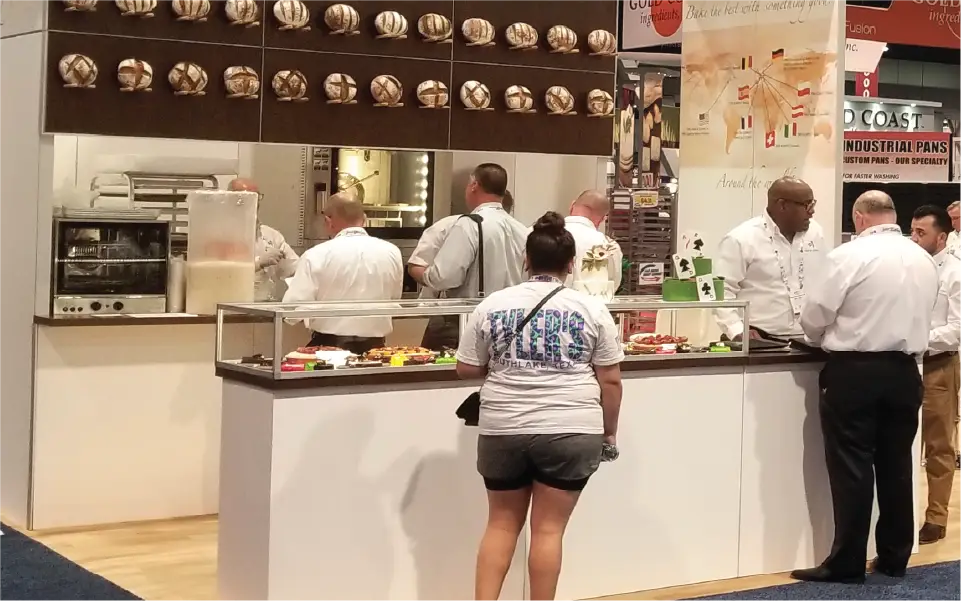
Pull marketing for trade shows is about making your products and or services visible, listenable, touchable even smellable to prospective buyers for immediate feedback and validation, as well as how to get a hold of you when interested or need a product or service and search for answers. Trade shows include a perfect combination of multiple strategic marketing components, and trade shows are the best format, venue, and window for companies to deploy surgical pull marketing strategies that reinforce and even drive their annual push/pull marketing strategies year-over-year.
Having vast knowledge across numerous marketing mediums, still, in my professional opinion, the trade show floor remains the ultimate environment to deploy an incomparable cache of marketing engagement tools under one roof if and ONLY the marketing, tools, personnel, and environment in which a company exhibits with are all accurately aligned with one another to facilitate the maximum PUSH and PULL opportunity companies will ever have.
Defining your company’s pull strategy defines the tools you will require on-site built into your trade show exhibit environment or structure. Set aside the closet, carpet, furniture finish, and hanging sign. However, although these elements are vital, they are not critical tools to support your company’s mission to pull or extract whatever your company is planning to remove from the event participation.

Whether it’s leads, demos, knowledge, sales, deals, referrals, relationships, or whatever, the investment is substantial, so you make it great!
Pull marketing also includes marketing channels like tracking website activity, search engine optimization (SEO) statistics, search engine marketing analytics, email opens tracking, blog post activity measurement, and social media marketing metrics…all of which can and should be deployed simultaneously to support well-built corporate trade show programs.
Push vs. pull marketing
A trade show is not the appropriate venue to invest time and resources to aggressively force your offers on those who may not be seeking your product or service (LVTs). After all, if the show were well researched, there would be an abundance of HVTs on the show floor your team should be specifically hyper-focused on engaging with. However, if your company’s push strategies are well crafted, you will still pull them (LVTs) into your booth to allow them to explore and evaluate professional synergies. There are often those rewarding connections that seemingly appear out of nowhere that we should be prepared for at all times, icing on the cake!
Whether you are a new company with minimal visibility or an established company with or without a new product offering, a push marketing strategy is essential. Once users have identified a need, you can implement your pull marketing tactics.
Although push marketing is intended to apply pressure for immediate reactions, conversations, or interactions, all of the above generate and complement long-term lucrative business relationships. Once relationships are formed, pull marketing is most effective to impress your customers. It offers an analytical approach to identify how best to serve them or the answers they seek before they ask. They will remain loyal to your brand when they have a great experience with that approach.
Now that you better appreciate Push/Pull Marketing Strategies, let’s wrap up with great ways to apply push and pull marketing strategies to your post-show follow-up as you follow THROUGH.
Post-show promotion
We have ALL been there…exhausted upon returning from the road and would like to do nothing more than curl up in a ball under a blanket and take a three-day nap! Not yet!! Lol!! Well, not unless you put everything necessary to follow up post-show in place before you even left for the show, and yes, this too is doable.
Yep, you can come home and catch your breath WHILE following up after the show! It just takes some pre-planning, implementation, and deployment before the event weeks or months ahead.
In fact, “the post-show follow-up” should be highly regarded as the #1 reason, first and foremost, why you all even thought about exhibiting at the event, to begin with, invested in the event, prepared for the event, sent key personnel to the event, etc……to obtain the resulting outcomes of the event, which nine times out of ten, pays back post-show. Just when you thought the going would get easy, it shouldn’t! It’s the beginning of the fourth down or third period (for the sake of working in thirds). It’s still anyone’s game, either yours or your competitors’… whichever one steps up the best to finish what they started…betting on the team that sticks to the discipline of 5-7 impressions or more!
Someone will receive an invite from their boss to celebrate their wins, while many will not experience a similarly themed meeting with management.
Some will receive an increased budget for the next show, and some will lose their budget altogether. The numbers will speak clearly for themselves and for you. This is why it is essential to appropriately complete the journey you started months prior with considerable effort on the back end of the marketing effort.
Note: Immediately get the show leads/badge scans and notes transferred to your CRM (before anything else). I cannot stress this enough from the show floor (in real-time), hotel, airport, plane, train, wherever!
“Post Show” marketing suggestions include:
- Handwritten thank you card with a calendar link or QR code to book a post-show meeting.
- Emailed thank you letter or note with a link to your calendar to book a post-show appointment.
- Digital Product Brochures (specific) displaying a link to your calendar or QR code to book a post-show meeting.
- Recap note about your show-floor conversations with a link to your calendar to book a post-show session.
- Extended Limited-time Offer with your calendar link to book a post-show meeting.
- keep retargeted ads running
- Phone calls, etc.
You must consistently create product demand and develop your lead pipeline as a marketer. Initially, push marketing spawns the market demand or need; pull marketing offers a way for users to satisfy that market or audience need.
I guarantee that the next time you plan your trade show with Push/Pull Marketing at the forefront of your planning and infuse it throughout the entire event cycle, your company leadership and attendees will appreciate the remarkable efforts and results!
Since 1957 DisplayCraft has been a full-service national exhibit builder and service provider, providing consultation, design, build, and program management to hundreds of clients across various industries. At DisplayCraft, we specialize in creating impactful brand experiences for our clients through our expertise in experiential marketing. We offer multiple services to help our clients succeed in their marketing efforts. These include designing effective marketing strategies, measuring return on investment, creating eye-catching designs, using advanced technology solutions, creating graphics, providing on-site support, and offering personalized exhibit rentals. Our satellite DisplayCraft facility in Las Vegas was strategically secured to better serve our clients on the west coast for trade shows and events. We are committed to meeting our client’s needs, whether they are domestic or international, and ensuring their success at every event.
DisplayCraft offers the “best of both worlds,” large enough to provide complete exhibit and event marketing services yet small enough to be cost-effective and highly service oriented.
Feel free to contact us to learn more.

